Abstract
LMB-7 [B3(Fv)-PE38] is a single-chain immunotoxin constructed from the murine monoclonal antibody B3 and a truncated from of Pseudomonas exotoxin PE38. Antibody B3 recognizes a carbohydrate epitope found on solid tumors that frequently invade the intrathecal space and cause neoplastic meningitis. We tested the therapeutic value of intrathecally administered LMB-7 by using a model of human neoplastic meningitis in athymic rats. This model is representative of a clinical situation in that antibody B3 cross-reacts with a number of normal tissues that can be used to monitor potential systemic toxicity. Treatment was begun 3 days after A431 tumor implantation. Without treatment, the animals median survival was 10 days. Intrathecal administration of 10 micrograms of LMB-7 in 40 microliters on days 3, 5, and 7 produced 4 of 10 and 8 of 10 long-term survivors (> 170 days) in two experiments. Of the long-term survivors, 2 of 4 and 7 of 8 survivors had no microscopic evidence of tumor and were considered histologic cures. Lack of significant toxicity in the effective dose range and specificity make LMB-7 an excellent candidate for intrathecal treatment of neoplastic meningitis in humans.
Full text
PDF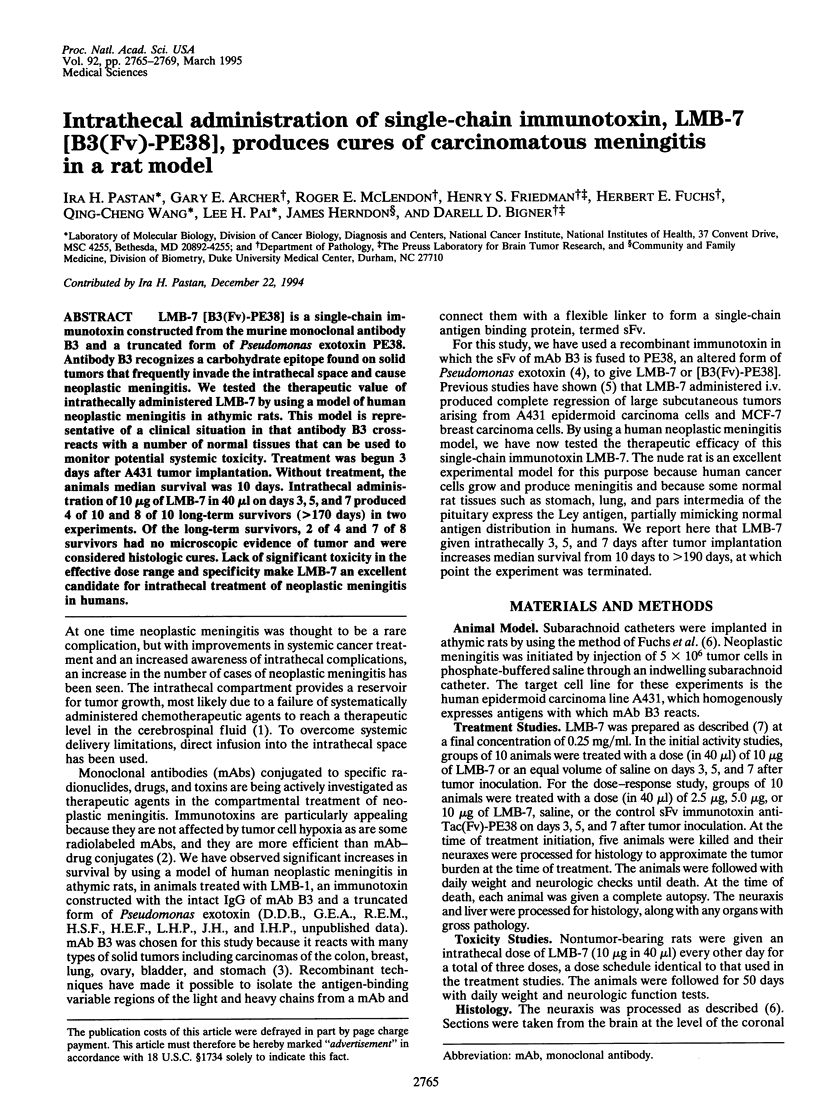
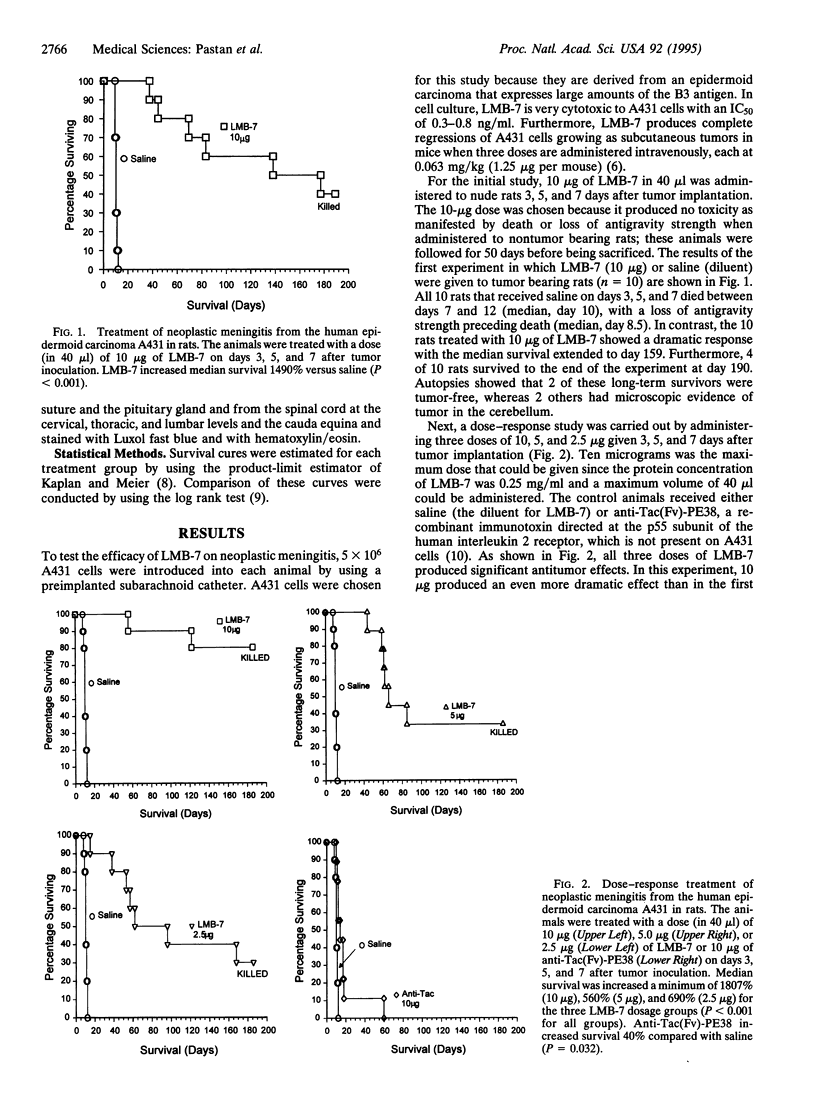
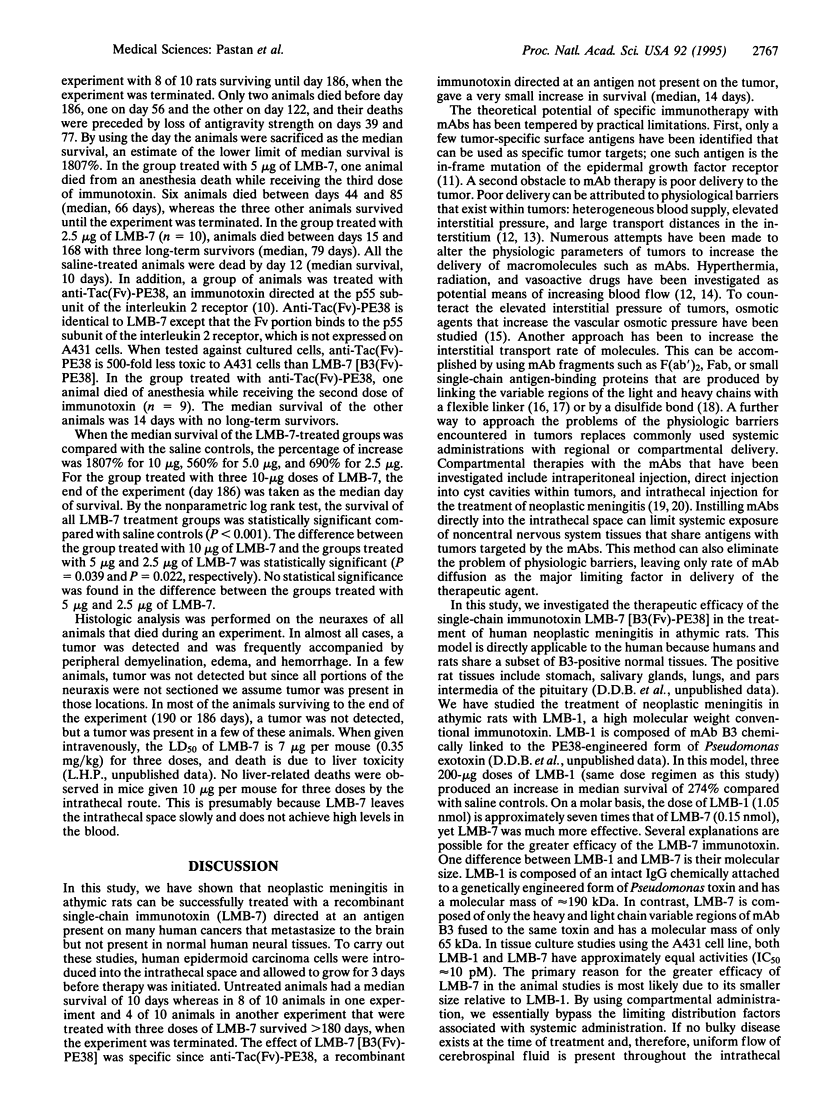
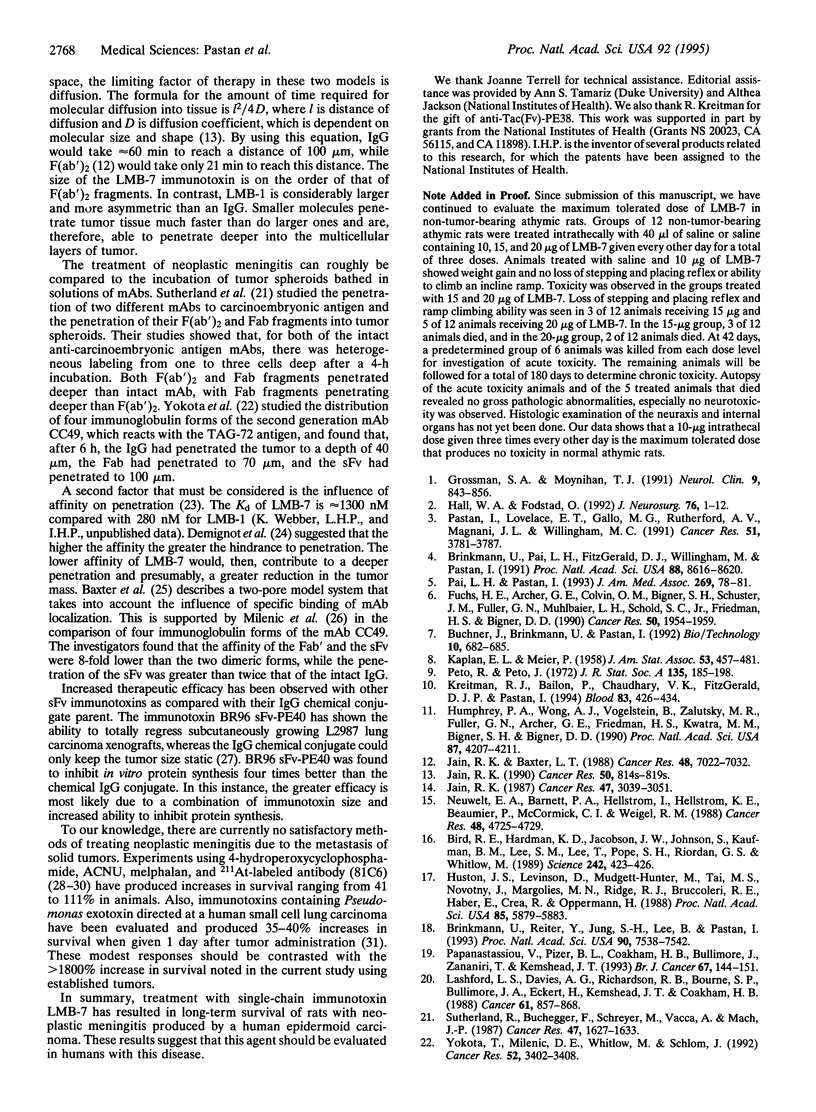
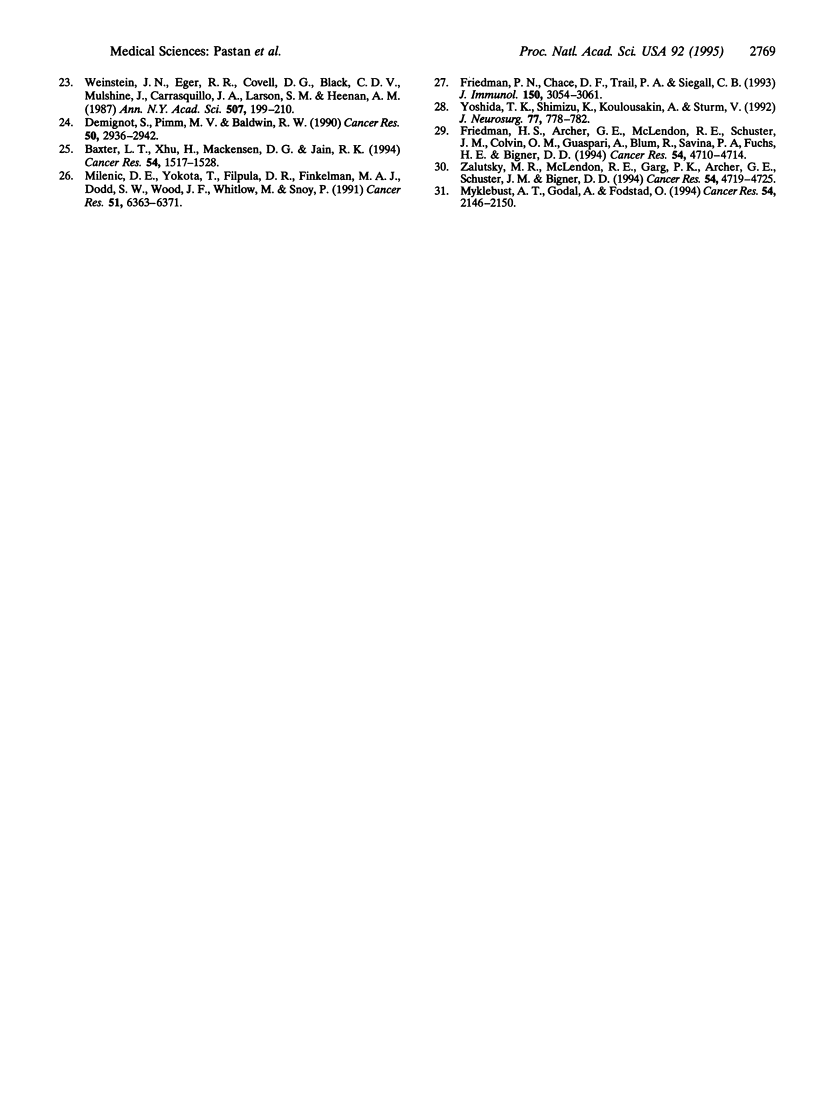
Selected References
These references are in PubMed. This may not be the complete list of references from this article.
- Baxter L. T., Zhu H., Mackensen D. G., Jain R. K. Physiologically based pharmacokinetic model for specific and nonspecific monoclonal antibodies and fragments in normal tissues and human tumor xenografts in nude mice. Cancer Res. 1994 Mar 15;54(6):1517–1528. [PubMed] [Google Scholar]
- Bird R. E., Hardman K. D., Jacobson J. W., Johnson S., Kaufman B. M., Lee S. M., Lee T., Pope S. H., Riordan G. S., Whitlow M. Single-chain antigen-binding proteins. Science. 1988 Oct 21;242(4877):423–426. doi: 10.1126/science.3140379. [DOI] [PubMed] [Google Scholar]
- Brinkmann U., Pai L. H., FitzGerald D. J., Willingham M., Pastan I. B3(Fv)-PE38KDEL, a single-chain immunotoxin that causes complete regression of a human carcinoma in mice. Proc Natl Acad Sci U S A. 1991 Oct 1;88(19):8616–8620. doi: 10.1073/pnas.88.19.8616. [DOI] [PMC free article] [PubMed] [Google Scholar]
- Brinkmann U., Reiter Y., Jung S. H., Lee B., Pastan I. A recombinant immunotoxin containing a disulfide-stabilized Fv fragment. Proc Natl Acad Sci U S A. 1993 Aug 15;90(16):7538–7542. doi: 10.1073/pnas.90.16.7538. [DOI] [PMC free article] [PubMed] [Google Scholar]
- Buchner J., Brinkmann U., Pastan I. Renaturation of a single-chain immunotoxin facilitated by chaperones and protein disulfide isomerase. Biotechnology (N Y) 1992 Jun;10(6):682–685. doi: 10.1038/nbt0692-682. [DOI] [PubMed] [Google Scholar]
- Demignot S., Pimm M. V., Baldwin R. W. Comparison of biodistribution of 791T/36 monoclonal antibody and its Fab/c fragment in BALB/c mice and nude mice bearing human tumor xenografts. Cancer Res. 1990 May 15;50(10):2936–2942. [PubMed] [Google Scholar]
- Friedman H. S., Archer G. E., McLendon R. E., Schuster J. M., Colvin O. M., Guaspari A., Blum R., Savina P. A., Fuchs H. E., Bigner D. D. Intrathecal melphalan therapy of human neoplastic meningitis in athymic nude rats. Cancer Res. 1994 Sep 1;54(17):4710–4714. [PubMed] [Google Scholar]
- Friedman P. N., Chace D. F., Trail P. A., Siegall C. B. Antitumor activity of the single-chain immunotoxin BR96 sFv-PE40 against established breast and lung tumor xenografts. J Immunol. 1993 Apr 1;150(7):3054–3061. [PubMed] [Google Scholar]
- Fuchs H. E., Archer G. E., Colvin O. M., Bigner S. H., Schuster J. M., Fuller G. N., Muhlbaier L. H., Schold S. C., Jr, Friedman H. S., Bigner D. D. Activity of intrathecal 4-hydroperoxycyclophosphamide in a nude rat model of human neoplastic meningitis. Cancer Res. 1990 Mar 15;50(6):1954–1959. [PubMed] [Google Scholar]
- Grossman S. A., Moynihan T. J. Neoplastic meningitis. Neurol Clin. 1991 Nov;9(4):843–856. [PubMed] [Google Scholar]
- Hall W. A., Fodstad O. Immunotoxins and central nervous system neoplasia. J Neurosurg. 1992 Jan;76(1):1–12. doi: 10.3171/jns.1992.76.1.0001. [DOI] [PubMed] [Google Scholar]
- Humphrey P. A., Wong A. J., Vogelstein B., Zalutsky M. R., Fuller G. N., Archer G. E., Friedman H. S., Kwatra M. M., Bigner S. H., Bigner D. D. Anti-synthetic peptide antibody reacting at the fusion junction of deletion-mutant epidermal growth factor receptors in human glioblastoma. Proc Natl Acad Sci U S A. 1990 Jun;87(11):4207–4211. doi: 10.1073/pnas.87.11.4207. [DOI] [PMC free article] [PubMed] [Google Scholar]
- Huston J. S., Levinson D., Mudgett-Hunter M., Tai M. S., Novotný J., Margolies M. N., Ridge R. J., Bruccoleri R. E., Haber E., Crea R. Protein engineering of antibody binding sites: recovery of specific activity in an anti-digoxin single-chain Fv analogue produced in Escherichia coli. Proc Natl Acad Sci U S A. 1988 Aug;85(16):5879–5883. doi: 10.1073/pnas.85.16.5879. [DOI] [PMC free article] [PubMed] [Google Scholar]
- Jain R. K., Baxter L. T. Mechanisms of heterogeneous distribution of monoclonal antibodies and other macromolecules in tumors: significance of elevated interstitial pressure. Cancer Res. 1988 Dec 15;48(24 Pt 1):7022–7032. [PubMed] [Google Scholar]
- Jain R. K. Physiological barriers to delivery of monoclonal antibodies and other macromolecules in tumors. Cancer Res. 1990 Feb 1;50(3 Suppl):814s–819s. [PubMed] [Google Scholar]
- Jain R. K. Transport of molecules in the tumor interstitium: a review. Cancer Res. 1987 Jun 15;47(12):3039–3051. [PubMed] [Google Scholar]
- Kreitman R. J., Bailon P., Chaudhary V. K., FitzGerald D. J., Pastan I. Recombinant immunotoxins containing anti-Tac(Fv) and derivatives of Pseudomonas exotoxin produce complete regression in mice of an interleukin-2 receptor-expressing human carcinoma. Blood. 1994 Jan 15;83(2):426–434. [PubMed] [Google Scholar]
- Lashford L. S., Davies A. G., Richardson R. B., Bourne S. P., Bullimore J. A., Eckert H., Kemshead J. T., Coakham H. B. A pilot study of 131I monoclonal antibodies in the therapy of leptomeningeal tumors. Cancer. 1988 Mar 1;61(5):857–868. doi: 10.1002/1097-0142(19880301)61:5<857::aid-cncr2820610502>3.0.co;2-s. [DOI] [PubMed] [Google Scholar]
- Milenic D. E., Yokota T., Filpula D. R., Finkelman M. A., Dodd S. W., Wood J. F., Whitlow M., Snoy P., Schlom J. Construction, binding properties, metabolism, and tumor targeting of a single-chain Fv derived from the pancarcinoma monoclonal antibody CC49. Cancer Res. 1991 Dec 1;51(23 Pt 1):6363–6371. [PubMed] [Google Scholar]
- Myklebust A. T., Godal A., Fodstad O. Targeted therapy with immunotoxins in a nude rat model for leptomeningeal growth of human small cell lung cancer. Cancer Res. 1994 Apr 15;54(8):2146–2150. [PubMed] [Google Scholar]
- Neuwelt E. A., Barnett P. A., Hellström I., Hellström K. E., Beaumier P., McCormick C. I., Weigel R. M. Delivery of melanoma-associated immunoglobulin monoclonal antibody and Fab fragments to normal brain utilizing osmotic blood-brain barrier disruption. Cancer Res. 1988 Sep 1;48(17):4725–4729. [PubMed] [Google Scholar]
- Pai L. H., Pastan I. Immunotoxin therapy for cancer. JAMA. 1993 Jan 6;269(1):78–81. [PubMed] [Google Scholar]
- Papanastassiou V., Pizer B. L., Coakham H. B., Bullimore J., Zananiri T., Kemshead J. T. Treatment of recurrent and cystic malignant gliomas by a single intracavity injection of 131I monoclonal antibody: feasibility, pharmacokinetics and dosimetry. Br J Cancer. 1993 Jan;67(1):144–151. doi: 10.1038/bjc.1993.25. [DOI] [PMC free article] [PubMed] [Google Scholar]
- Pastan I., Lovelace E. T., Gallo M. G., Rutherford A. V., Magnani J. L., Willingham M. C. Characterization of monoclonal antibodies B1 and B3 that react with mucinous adenocarcinomas. Cancer Res. 1991 Jul 15;51(14):3781–3787. [PubMed] [Google Scholar]
- Sutherland R., Buchegger F., Schreyer M., Vacca A., Mach J. P. Penetration and binding of radiolabeled anti-carcinoembryonic antigen monoclonal antibodies and their antigen binding fragments in human colon multicellular tumor spheroids. Cancer Res. 1987 Mar 15;47(6):1627–1633. [PubMed] [Google Scholar]
- Weinstein J. N., Eger R. R., Covell D. G., Black C. D., Mulshine J., Carrasquillo J. A., Larson S. M., Keenan A. M. The pharmacology of monoclonal antibodies. Ann N Y Acad Sci. 1987;507:199–210. doi: 10.1111/j.1749-6632.1987.tb45802.x. [DOI] [PubMed] [Google Scholar]
- Yokota T., Milenic D. E., Whitlow M., Schlom J. Rapid tumor penetration of a single-chain Fv and comparison with other immunoglobulin forms. Cancer Res. 1992 Jun 15;52(12):3402–3408. [PubMed] [Google Scholar]
- Yoshida T. K., Shimizu K., Koulousakis A., Sturm V. Intrathecal chemotherapy with ACNU in a meningeal gliomatosis rat model. J Neurosurg. 1992 Nov;77(5):778–782. doi: 10.3171/jns.1992.77.5.0778. [DOI] [PubMed] [Google Scholar]
- Zalutsky M. R., McLendon R. E., Garg P. K., Archer G. E., Schuster J. M., Bigner D. D. Radioimmunotherapy of neoplastic meningitis in rats using an alpha-particle-emitting immunoconjugate. Cancer Res. 1994 Sep 1;54(17):4719–4725. [PubMed] [Google Scholar]


